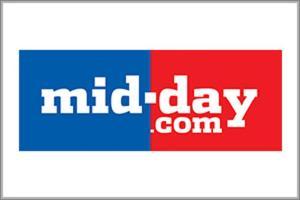With Jyotiraditya Scindia admitting that India may well allow FDI in retail, and supermarket giants networking with the Indian government at the just-concluded World Economic Forum in Davos, what you'll be eating, buying and believing in the coming year is about to change. Yolande D'mello brings you the lowdown on grocery trends, and how your supermarket will look different, and stock differently, soon

So, why would you, who if given a choice, rather headbang before a TV screen that plays VH1 than watch a biz journo spew fiscal data, care?

At HyperCITY in Malad, fresh fruits and vegetables are displayed at
circular counters, not stacked on linear shelves. PIC/Anuja Gupta
Because someone by the name Vince Cable, who happens to be Britain's Business Secretary, recently told Indian ministers how our current food crisis, the iconic symbol of which is the soon-touching-the-price-of-gold onion, can be minimised if supermarket giants like Tesco, were allowed to set up shop in India.
What this means is a whole new, giant supermarket shopping experience waiting to engulf you. In fact, Tesco Chief Executive Terry Leahy blurted an excited, "yes, yes" at the just-concluded World Economic Forum in Davos, when he was asked if the global supermarket chain with headquarters in the UK, would go ahead with investments in India, without waiting for the opening up of FDI in retail. At present, foreign retail brands can only enter through partnerships with local ones.
Giants on their way
In a joint venture with Future Group, Carrefour, the world's second largest wholesale marketer, opened its first 5,200 square metre cash-and-carry store in Seelampur near New Delhi on December 31, 2010.
World leader Wal-mart entered the Indian market in 2009 after tying up with Bharati Enterprises, to set up shop in Amritsar. And with the world's top retailers choosing the economic meet in the Swiss Alps to network with the Indian government, what you'll be eating, buying and believing in the coming year, is about to undergo a sea change.
With growing competition, supermarkets are going to spend longer hours brainstorming about how to entice the shopper. In the West, local grocery stores are likely to tempt customers with in-house spa treatments and free consultations with nutritionists, experts predict. American supermarket chains like Kroger and Wegmans have already launched upscale restaurants and bars within their premises. For the stressed, urban customer, a personalised shopping experience is tempting enough.

What I need Vs What I want Essentials like grains, aata and pulses are
placed at the back of the supermarket. This way, the customers must
walk past seasonal products to get to essentials, that they end up
buying too. Illustration/ Jishu
Taste before you buy
Last Tuesday, Mohit Khattar, managing director and CEO, Godrej Nature's Basket Ltd. dropped by at the Juhu branch of the gourmet world food retail chain to check the response to their "try our meat platter" offer that was introduced within a week of the store opening for business. Their taste-before-you-buy policy offers the customer an interactive experience, and in this case, a taste of cooked and seasoned fish, lamb, turkey and emu, to make buying the raw stuff easier. "It's as simple as asking yourself, 'What is your business and, who are you selling to?' Once you know the answer to these questions, it's just about following through," says the 44 year-old.u00a0
In another corner, a counter that displays exotic cheeses from Emmental to Gouda is manned by a hotel management graduate, who will happily offer you a cube on a toothpick while indulging you in conversation about which one will go best as garnish on a jeera cracker biscuit.
"India is not a cheese country, but we have decided to sell cheese. So, then we must decide who exactly fits our target group. We aimed the store at an up-market clientele that's well-travelled, and likes to indulge in the good stuff," says Khattar.u00a0
Culturally, Indians love to be pampered. "Self help doesn't work here as well as it does in other countries," says Khattar. Indians like to be asked what they are looking for, and then talked into buying the product. This makes hiring well-trained staff crucial to assert the right degree of purchasing pressure while offering the customer his space.
Nature's Basket emerged in 2005 as a fresh fruits and vegetable store, and adapted the gourmet tag in 2008 after studies suggested that a niche store offering international brands of lifestyle products would work.
Today, they deal exclusively in cheese, wine, tea and coffee, marinades and meats.
They are fast expanding. Currently, they have nine stores in Mumbai, three in Delhi, and the first Pune branch is scheduled to open by the first week of February.
Aisle or shelves?
Experts like Khattar will tell you you that what you buy is hardly ever determined by what you need. Even before you set foot inside a store, marketers have traced the route you will take. A team of store designers zero in on signage, textures and colours that best reflect the brand image, while layout designers figure the network and placements of aisles and racks.
Khattar says the layout of Nature's Basket was designed to look premium and comfortable, without resorting to the traditional supermarket design that includes aisles. Instead, it offers products on shelves that are built low so that customers can browse for longer.
Big Bazaar, a chain of Indian hypermarkets, and a subsidiary of Future Group Limited, is said to follow the business model of US-based Wal-mart. But its Manager, Integrated Food Section, Damodar Mall, says, being local is crucial. "Indian supermarkets are more influenced by the local sabzi mandi than models of the West. India is an assertive market. What works successfully elsewhere does not necessarily work here. We can't piggyback on results derived elsewhere," says Mall.
The Big Bazaar stores don't have false ceilings, and make do with Kota stone floors and simple white lighting. "We don't want to create a five-star hotel feel because that would intimidate the average Indian customer. We prefer noise and activity; that's an environment in which the Indian customer is comfortable," shares Mall.
What sits where
Culture defines far more than how a grocery store will look. For instance, Wal-mart's Amritsar model is likely to look different from its sister-branch in Detroit. The fresh meat section at Indian supermarkets stand apart in a cosy nook, often closed in by a glass door, like at Nature's Basket's Mahalaxmi branch, so as not to offend vegetarian shoppers.
"We also separate our wine and beers from other product sections because women might be offended to see a beer can sit beside a bottle of cola she wants to buy," says Esha Anand, Marketing and Visual Merchandising head, HyperCITY.
And the design and layout plays more than just an aesthetic role.
That cut-out is luring you
Your shopping cart often takes an unconscious detour thanks to floor graphics called planograms, cut-outs that pop out of shelves, and LCD screens that flash images; not to mention the syrupy voice that wafts from speakers, announcing a 50 per cent killer discount. In-store branding or point of purchase promotion, as it is called, refers to subtle or in-your-face attempts to grab your attention.
"Visual merchandising is the shopkeeper dialogue we can't have with each and every customer," says Mall. "We can't bargain but we know the Indian customer wants value for money, so we exhibit planograms about how the customer can save."
Big Bazaar, the first chain of supermarkets in the country, has evolved with customer evolution. The changes are subtle. Three years ago, face wash was found in the cosmetics section. Now it sits next to soaps and shampoos. "The fridges today are larger, so customers tend to shop for fruits and vegetables once a week. As soon as you enter any of our stores, you will see a massive space dedicated to fresh foods, offering a visual arrangement similar to a market place," says Mall.u00a0
The silent data collectors
In addition to surveys commissioned that help establish a customer satisfaction index, stores use loyalty cards to group buyers based on the choice of their purchases, and the frequency of their visits.
Shoppers love a surprise, and if a customer shopping for a refrigerator is going to open the double door and find attractive frozen yoghurt tubs inside, it's an add-on to the shopping experience.
Free trials and sampling sessions are a hit with Indian shoppers. When Minute Maid launched its breakfast special, Big Bazaar organised a sampling session, with steaming poha and upma being served to customers, warming them to the idea of picking up a packet.
It's the area between the main aisles, a motorway for high footfall, is usually picked for sampling sessions and promotions.
When UHT tetra pack milk didn't pick up with Indian families, HyperCITY commissioned a survey to figure how the customer would like his milk packed. Eight per cent of consumers were unaware of the difference between packet milk and packaged milk, and believed the latter was more expensive. An aggressive store promotion involved staff members approach customers with a fact file on the safety of consuming carton milk. Ashutosh Chakradeo, Head of Buying and Merchandise, HyperCITY, says the store saw an instant rise in sales.u00a0
And it is not just the method of packaging, but the packaging itself that's going to change. The anti-plastic fever will make cardboard tetra packaging and compostable pouches commonplace. And with Coca-Cola already introducing a plastic-free bottle made partly from sugarcane sourced from India and Brazil, you might soon be glugging your 'thanda' from a bio-bottle.
What you see is what you buy
research reveals that products placed at eye level are more likely to be picked up than those placed above or below. And so, kids' products are strategically placed on lower shelves. With bright colourful packaging, they are in a better position to catch the eye of a child who then uses pester power to convince the parent about a purchase.
The forecast
Kiosk with IQ that will tell you what you should buy
The Internet-connected touch screen kiosk is a device developed by Intel Corporation that was introduced to the world at the 2010 Consumer Electronics Show by Intel CEO Paul Otellini. The kiosk located inside the store is activated simply by a customer loyalty card that pulls up the customer's history of past purchases and then suggests items based on a list of tastes and preferences derived from this information. The interactive LCD screen allows the customer to store these suggestions on his/her phone and access store catalogues. It offers retailers the chance to give the customer exactly what he wants while giving the customer a uniquely personal shopping experience.
Smartphone app for special diet followers
It's believed that in the future smartphone apps will make grocery shopping easier. The customer will be able to scan the barcode of a food item picked up, check if it contains a certain ingredient or whether it's gluten-free. It could also include user reviews so you know what others who've tried the item think of it.
The Handbook
Your guide to deciphering the anatomy of a supermarketu00a0
The Entry: The store experience begins outside the entrance where the signage of the brand stands. What marketers call 'curb appeal' refers to the first impression left on the customer. That will determine if he/she will walk in or not. Windows are kept large, and lighting bright. The entrance is always wide.u00a0
u00a0
The Dwell Zone: As soon as the shopper is inside, he is given a chance to 'recover' from the environment outside. The shopper has a lot to take in, very often with 50,000 sq feet filled with thousands of products, he stops in his tracks to decide what comes on the shopping list first.u00a0
u00a0
That's Right: Surveys suggest that 75% customers tend to look right after they enter a supermarket. The area immediately to the right of the entrance and the dwelling zone is used to display special offers and promotional items.
u00a0
The Power Isle: Right through the centre of the store, this forms a major route that buyers have to take to get round the store. The most aggressive promotions are displayed here, showing customers which departments carry bargains, drawing them to these areas.u00a0
u00a0
Food neighbours: Supermarkets cash in on the fact that buyers today are strapped for time, and looking for a quick fix. Chopped vegetables don't work as well in India but ready packets of cleaned corn are always appreciated and sell faster. Placing products that could make a meal next to each other is referred to as 'adjacency'. Here, the night's or next day's menu is subconsciously suggested to the buyer.
Source: Marketing Management by Philip Kotler
 Subscribe today by clicking the link and stay updated with the latest news!" Click here!
Subscribe today by clicking the link and stay updated with the latest news!" Click here!











